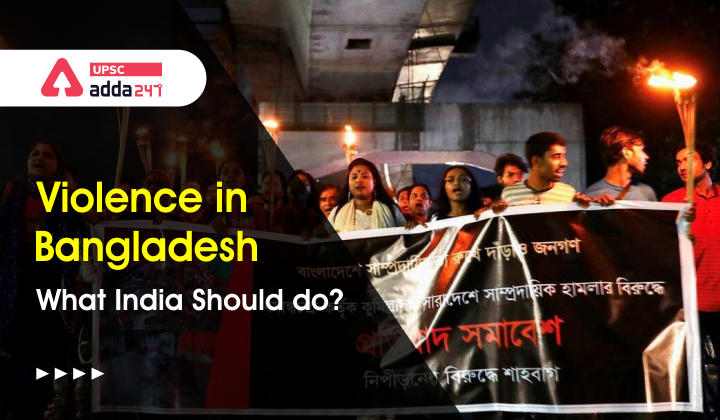G.S. Paper 2: International Relations
Context:
Since October 13, 2021, Bangladesh has witnessed a yet again series of targeted attacks on the Hindu communities residing in a number of districts.
Background:
Violence had erupted in pockets of Bangladesh over an alleged blasphemy incident at a Durga Puja pavilion at Cumilla, around 100 km from Dhaka, following which paramilitary forces were deployed in many affected areas.
Minorities frustrated
- Minorities rely on the Government to ensure their safety. The recent attacks had left them frustrated.
- The Minority Hindu community in Bangladesh is looking at the Indian government for a helping hand.
Hindu Minority Population in Bangladesh:
- Bangladesh has a population of over 160 million. According to the 2013 Census, Sunni Muslims constitute 89% of the population and Hindus 10%. The remaining population is predominantly Christian, mostly Roman Catholic, and Theravada-Hinayana Buddhist. The country also has a small number of Shia Muslims, Ahmadiyya Muslims and Biharis.
Is it a new trend?
Data shared by the Ain o Salish Kendra (ASK), a Bangladeshi human rights body, give a clearer picture of what has been happening in the country for years now. According to the ASK, as many as 3,710 attacks on the Hindu community took place between January 2013 and September 2021.
Some Incidents of Rumour Based Violence:
- On September 29 and 30, 2012, an unruly mob reportedly unleashed violence on the Buddhist community in Ramu by spreading a rumour.
- Moreover, the post-election violence in 2014 was still fresh in the minds of the Hindu community.
- On October 30, 2016, a mob reportedly vandalised around 10 temples and ransacked over 100 houses belonging to the Hindu community in the area over an alleged defamatory Facebook post by a Hindu youth, Rasraj Das, in Nasirnagar Upazila at Brahmanbaria.
Why this Violence:
- The burning question is why radicals do these to the Hindus who had done them no wrong, who are a helpless, beleaguered, tiny minority? One reason is obvious: Because they are helpless, they are fair game.
- This had been done by the Nazis against the Jews, by Whites against Africans or people of African descent in South Africa and the US South, by the Muslim Turks against Christian Armenians.
- Next, there is the jihadi craze. This is an Islamic country, and kafirs, Hindus, idol-worshippers (the Bangladeshi pejorative term is malaun) will not be allowed to live here — let them go to Hindustan, or else we’ll kill them!
- The tormentors also know that the political ethos of India is such that there will never be any retaliation of these against Indian Muslims.
- And the Hindus are still possessed of considerable real estate. If the Hindus go away all that property will be theirs.
- In fact, huge chunks of real property originally belonging to Hindus have already been expropriated by Muslims.
Constitutional Rights of Minorities in Bangladesh
- The Constitution has not clearly defined ‘minorities’ though Bangladesh as a member of the international community is duty-bound to protect them from all forms of discrimination and violence.
- The protection of minorities was overlooked in the 1972 Constitution, and only very recently in 2011 a special provision to protect and develop the “unique local culture and tradition of the tribes, minor races, ethnic sects and communities” has been placed in the Constitution through the 15th Constitutional Amendment (Article 23A).
- Constitution designates Islam as the state religion but upholds the principles of secularism in practice.
India’s Response:
- India acknowledged the “prompt” steps taken by the Government of Bangladesh with the additional deployment of security forces following the vandalism of Hindu temples and Durga Puja venues.
- The Indian High Commission in Dhaka was in touch with law and order officials at the Centre.
- It has stepped in to meet the members of the Bangladeshi Hindu community, including representatives from the ISKCON group that was attacked.
What Should be India’s ShortTerm Plan:
- Recent violence triggered a sense of fear and helplessness among the thousands of Hindus living in Bangladesh. In this situation, India should be diplomatically engaging Bangladeshi officials to normalise the situation.
- A few months ago present Prime Ministers of both countries termed recent times as a shonali adhayay (golden chapter) in the Indo-Bangladesh relations. So, India should handle the present situation with due care without affecting the ongoing good relations.
What Should be India’s Long Term Plan:
- According to many surveys and reports, in the shadow of recent developments in Afghanistan and other middle east countries, the trend of radicalism is going to increase more and more among Bangladeshi Muslims. Considering this, the Indian government should go for a long term strategic move for helping the minorities there.
- Bangladesh shares its border with four eastern States in India: West Bengal, Tripura, Assam and Meghalaya and it shares a lot of cultural and linguistic similarities with the States of Assam, West Bengal and Tripura. So, whatever happens there impacts the people of our country.
- So, India should always strengthen ties through various cultural and intellectual exchanges with Bangladesh, which would rather have long-term positive implications.
Conclusion:
Prime Minister Sheikh Hasina’s response to the heinous crimes by sending paramilitary forces to contain violence is a welcoming step however, India should continue to pressurise the Bangladesh Government through diplomatic route for a crackdown on extremist elements that fan anti-Hindu sentiments in the country. Apart from that India should also prepare itself for future adversaries in Bangladesh, especially when the present regime changes in Bangladesh.



 TSPSC Group 1 Question Paper 2024, Downl...
TSPSC Group 1 Question Paper 2024, Downl...
 TSPSC Group 1 Answer key 2024 Out, Downl...
TSPSC Group 1 Answer key 2024 Out, Downl...
 UPSC Prelims 2024 Question Paper, Downlo...
UPSC Prelims 2024 Question Paper, Downlo...




